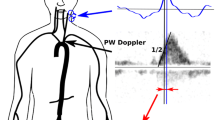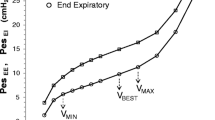Abstract
An attempt was made to measure the compliance and elastic modulus of the thoracic aorta from simultaneous recordings of the transthoracic admittance plethysmogram and intra-aortic pressure in living dogs. Initially, the compliance values determined by this method were correlated with those measured from the volume-pressure relationships in three different silicone-rubber tubes; these two groups of values were consistent with each other within the error range of ±10%. The mean value of the compliance of the thoracic aortae in four normal dogs (13–15 kg) measured by this method was 0·00387±0·00100 ml/mmHg cm. The elastic modulus E and velocity v of the pulse wave were calculated from this value; E=2·71±0·79×105 dN/m2 and v=4·52±2·44 m/s. These data were compared with those reported previously by other investigators. Taking simplicity, safety and practicability into consideration, it was concluded that this method would only be useful in clinics for the rough estimation of the elastic properties of the thoracic aorta.
Sommaire
Un essai a été entrepris pour mesurer le comportement et le coéfficient d'élasticité de l'aorte thoracique à partir d'enregistrements simultanés du pléthysmogramme d'admission transthoracique at de la pression intra-aortique dans des chiens vivants. Initialement, les valeurs de comportement déterminées par cette méthode furent associées à celles qui étaient mesurées à partir des rapports volume-pression dans trois tubes en caoutchouc de silicone différents. Ces deux groupes de valeurs étaient compatibles les unes avec les autres dans les limites de la gamme d'erreur de ± 10%. La valeur moyenne du comportement de l'aorte thoracique dans quatre chiens normaux (13–15 kg), relevée par cette méthode, était de 0,00387±0,00100 ml/mm Hg-cm. Le coéfficient d'élasticitéE et la vitesse de l'onde d'impulsion ν furent également déterminés à partir de cette même valuer, à savoir: E=2,71±0,79×106 dynes/cm2 et ν=4,52±2,44 m/s. Ces données furent ensuite comparées à celles qui avaient été précédemment formulées par d'autres enquêteurs. En tenant compte des facteurs de simplicité, sécurité et praticabilité, on en a conclu que cette méthode ne serait utile que dans les cliniques pour les évaluations approximatives des propriétés élastiques de l'aorte thoracique.
Zusammenfassung
Es wurde ein Versuch gemacht, die Übereinstimmung und das Elastizitätmodul der thorakalen Aorta durch gleichzeitiges Aufnehmen eines transthorakalen Admittanz-Plethysmogramms und Druck in der Aorta an lebenden Hunden zu messen. Anfänglish wurden die Übereinstimmungswerte, die durch dieses Verfahren bestimmt wurden, auf die mit Volumen-/ Druckverhältnis in drei verschiedenen Silikongummischläuchen gemessenen aufeinander in bezug gebracht. Diese beide Wertegruppen waren im Fehlerbereich von ±10% einheitlich. Der Mittelwert der Übereinstimmung der thorakalen Aorta bei vier normalen Hunden (13–15 kg), der mit diesem Verfahren gemessen wurde, betrug 0,00387±0,00100 ml/mm Hg/cm. Das ElastizitätsmodulE und die Geschwindigkeit der Impulswelle ν wurden von diesem Wert berechnet. E 3 2,71±0,79×106 Dyn/cm2 undv 3 4,52±2,44 m/s. Diese Daten wurden mit den schon früher von anderen Untersuchern vorgestellten verglichen. Unter Berücksichtigung von Einfachheit, Sicherheit und Durchführbarkeit wurde geschlossen, daß dieses Verfahren nur in der Klinik zur groben Schätzung der elastischen Eigenschaften der Thoraxaorta nützlich sein würde.
Similar content being viewed by others
References
Arndt, J. O., Klauske, J. andMersch, F. (1968) The diameter of the intact carotid artery in man and its change with pulse pressure.Pflügers Archiv. 301, 230–240.
Arndt, J. O., Stegall, H. F. andWicke, H. J. (1971) Mechanics of the aortain vivo:Circulation Res:28, 693–704.
Baker, L. E. (1971) Biological applications of electrical-impedance impedance measurements.In: IEE Medical Electronics Monographs 1–6, Hill, D. W. and Watson, B. W. (Eds.). Peter Peregrinus Ltd., 1–42.
Barnett, G. O., Mallos, A. J. andShapiro, A. (1961) Relationship of aortic pressure and diameter in the dog.J. Appl. Physiol. 16, 545–548.
Bergel, D. H. (1961a) The elastic properties of the arterial wall.J. Physiol. 156, 445–457.
Bergel, D. H. (1961b) The dynamic elastic properties of the arterial wall.156, 458–469.
Cooley, W. L. (1972) The calculation of cardiac stroke volume from variations in transthoracic electrical impedance.Biomed. Eng. 7, 316–319.
Gow, B. S. andTaylor, M. G. (1968) Measurement of viscoelastic properties of arteries in the living dog.Circulation Res. 23, 111–122.
Ito, H., Yamakoshi, K. andTogawa, T. (1976a) Transthoracic admittance plethysmograph for measuring cardiac output.J. Appl. Physiol. 40, 451–454.
Ito, H., Yamakoshi, K. andYamada, A. (1976b) Physiological and fluid-dynamic investigations of the transthoracic impedance plethysmography method for measuring cardiac output: Part II., Analysis of transthoracic impedance wave by perfusing dogs.Med. & Biol. Eng. 14, 373–378.
Kinnen, E., Kubicek, W. G. andPatterson, R. P.: (1964) Thoracic cage impedance measurements. Impedance plethysmographic determination of cardiac output (a comparative study). Technical Documentary Report No. SAM-TDR-64-15, USAF School of Aerospace Medicine, Brooks Air Force Base, Texas, 1–8.
Kinnen, E. (1970) Cardiac output from transthoracic impedance variations.Ann. NY Acad. Sci. 170, 747–756.
Kubicek, W. G. Karnegis, J. N., Patterson, R. P., Witsoe, D. A. andMattson, R. H. (1966) Development and evaluation of an impedance cardiac output system.Aerospace Med. 37, 1208–1212.
Kubicek, W. G., Patterson, R. P. andWitsoe, D. A. (1970) Impedance cardiography as a noninvasive method of monitoring cardiac function and other parameters of the cardiovascular system.Ann. NY Acad. Sci. 170, 724–732.
Leitz, K. H. andArndt, J. O. (1968) Die Durchmesser-Druck-Beziehung des intakten Gefäßgebietes der A. carotis communis von Katzen.Pflügers Archiv 301, 50–69.
McDonald, D. A. (1968) Regional pulse-wave velocity in the arterial tree.J. Appl. Physiol. 25, 73–78.
McDonald, D. A. (1974)Blood flow in arteries. 2nd Ed. Edward Arnold, 496.
Nyboer, J. (1947) Electrical impedance plethysmograph.In: Medical physics Vol. 1, byGlasser, O. (Ed.). The Year Book Publ., 340–341.
Patel, D. J., de Freitas, F. M., Greenfield, J. C. Jun. andFry, D. L. (1963) Relationship of radius to pressure along the aorta in living dogs.J. Appl, Physiol. 18, 1111–1117.
Patel, D. J., Janicki, B. S. andCarew, T. E. (1969) Static anisotropic elastic properties of the aorta in living dog.Circulation Res. 25, 765–779.
Patterson, R. T. (1965) Cardiac output determinations using impedance plethysmography. Thesis submitted to the Faculty of the Graduate School of the Unversity of Minnesota, Minneapolis, Minnesota, pp. 92.
Peterson, L. H., Jensen, R. E. andParnell, J. (1960) Mechanical properties of arteriesin vivo.Circulation Res. 8, 622–639.
Peterson, L. H. (1962) Properties and behaviour of living vascular wall.Physiol. Rev. 42 (Suppl. 5), 309–325.
Remington, J. W. andMimilton, W. F. (1945) The construction of a theoretical cardiac ejection curve from the contour of the aortic pressure pulse.Amer. J. Physiol. 144, 546–556.
Woodcock, J. P. (1974) Plethysmography.Biomed. Eng. 9, 405–409, 417.
Yamakoshi, K., Ito, H., Yamada, A., Tomino, T. andMiura, S. (1976) Physiological and fluid-dynamic investigations of the transthoracic impedance plethysmography method for measuring cardiac output: Part I, A fluid-dynamic approach to the theory using an expansible tube model.Med. & Biol. Eng. 14, 365–372.
Yamakoshi, K., Togawa, T. andIto, H. (1977) Evaluation of the theory of cardiac output computation from transthoracic impedance plethysmogram.Med. & Boil. Eng. & Comput. 15.
Author information
Authors and Affiliations
Rights and permissions
About this article
Cite this article
Ito, H., Yamakoshi, Ki., Shimazu, H. et al. Measurement of aortic compliance from the transthoracic admittance plethysmogram in the living dog. Med. Biol. Eng. Comput. 15, 618–626 (1977). https://doi.org/10.1007/BF02457919
Received:
Accepted:
Issue Date:
DOI: https://doi.org/10.1007/BF02457919




